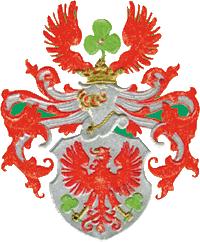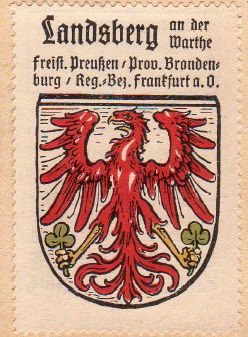Gorzów Wielkopolski: Difference between revisions
Knorrepoes (talk | contribs) m (Text replacement - ".hagd.jpg|center]] <br/>The arms by Hupp in the Kaffee Hag albums +/- 1925" to ".hagd.jpg|center|Wappen von {{PAGENAME}}]] <br/>The arms by Hupp in the Kaffee Hag albums +/- 1925 ") |
Knorrepoes (talk | contribs) m (Text replacement - ".jpg|center]] ====Official blazon====" to ".jpg|center|Arms of {{PAGENAME}}]] ====Official blazon====") |
||
| Line 5: | Line 5: | ||
Province: [[Lubusz]]<br> | Province: [[Lubusz]]<br> | ||
[[File:gorzowwi.jpg|center]] | [[File:gorzowwi.jpg|center|Arms of {{PAGENAME}}]] | ||
====Official blazon==== | ====Official blazon==== | ||
Revision as of 10:19, 26 March 2016
GORZÓW WIELKOPOLSKI
Province: Lubusz
Official blazon
Origin/meaning
Since 1257 Gorzów, and neighbouring Myslibórz, Barlinek, Choszczn, Lipiany, Ośno Lubuskie, have eagles on their coats of arms. This symbolises the sign of an eagle used by Brandenburgian margraves who once owned these towns. By giving their coat of arms they were symbolically giving the towns their care and support.
The first heraldic arms of Gorzów is on the town's seal which comes from 1351. The other seal comes from 1444. The symbol is the same - the Brandenburgian eagle. Since 1541 the eagle is holding leaves of clover in its talons. The other towns change their arms in the same way.
It is not quite konwn when the current coat of arms came into use. At Mariacki Church there is a black gothic eagle. This became more fashionable and effective during the baroque era. This can also be ssen on the town's seals from 1707 - there is a heraldic arms with helmet and diamond, and as a crest two eagle's wings enclosing a trefoil (see below).
| The arms as used in the 19th century |
The arms by Hupp in the Kaffee Hag albums +/- 1925 |
The arms as shown in 1963 |
Contact and Support
Partners:
Your logo here ?
Contact us
© since 1995, Heraldry of the World, Ralf Hartemink 
Index of the site
Literature : Plenako and Wanag, 1994; Background provided by Tomasz Ernest Domaradzki; Szczechura, 1963













